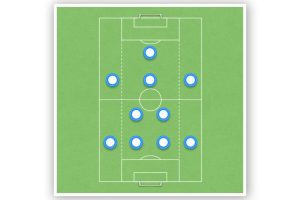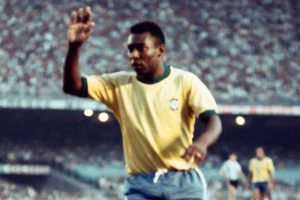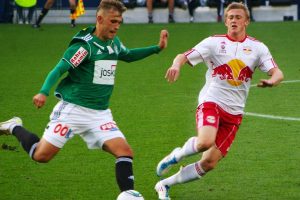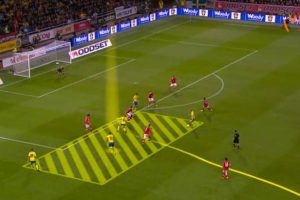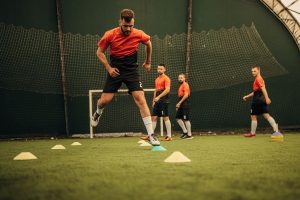What is the Hardest Position in Soccer? Exploring the Demands and Challenges of Each Role
Soccer is a sport that requires exceptional physical and mental abilities from its players. Each player on the field has a specific role to fulfill, and every position has its unique challenges. However, some positions are considered harder than others due to the specific skills and abilities required to perform them effectively.
When it comes to soccer, the hardest position is a topic of much debate among players, coaches, and fans alike. Some argue that the goalkeeper is the most challenging position due to the immense pressure and responsibility of protecting the goal. Others believe that fullbacks or central midfielders have the toughest job due to their need to defend, attack, and cover vast areas of the field.
In this article, we will explore the question of what is the hardest position in soccer. We will examine the various positions on the field and the skills and abilities required to excel in each of them. By the end of this article, readers will have a better understanding of the challenges and demands of each position and why some are considered harder than others.
Overview of Soccer Positions
Soccer is a sport that requires a team effort to achieve success. Each player on the field has a specific role to play, and their position determines their responsibilities. There are three main categories of positions in soccer: defensive, midfield, and forward.
Defensive Positions
The defensive positions in soccer are responsible for protecting the team’s goal and preventing the opposing team from scoring. The goalkeeper is the last line of defense and is the only player allowed to use their hands. They are responsible for stopping shots on goal and distributing the ball to their teammates.
The other defensive positions are the center backs and fullbacks. The center backs are positioned in the center of the defense and are responsible for marking the opposing team’s strikers. The fullbacks play on the outside of the defense and are responsible for both defending and supporting the team’s attacking play.
Midfield Positions
The midfield positions in soccer are responsible for controlling the flow of the game. They are the link between the defense and the attack and are responsible for both defending and attacking.
The central midfielders are positioned in the center of the field and are responsible for controlling the game’s pace and distributing the ball to their teammates. The defensive midfielders are responsible for breaking up the opposing team’s attacking play and protecting the defense. The attacking midfielders are responsible for supporting the team’s strikers and creating scoring opportunities.
Forward Positions
The forward positions in soccer are responsible for scoring goals. The strikers are positioned at the front of the attack and are responsible for finishing scoring opportunities. The wingers play on the outside of the attack and are responsible for creating scoring opportunities for the team’s strikers.
In conclusion, each position in soccer plays a unique and vital role in the team’s success. Whether it is the goalkeeper protecting the team’s goal or the strikers scoring goals, each position is important. Understanding the different positions and their responsibilities is essential for any soccer player or fan.
The Hardest Position in Soccer
When it comes to soccer, there is no doubt that every position on the field comes with its unique set of challenges. However, some positions are undoubtedly more challenging than others. One position that is widely considered to be the hardest in soccer is the goalkeeper.
The goalkeeper is the last line of defense for their team and is responsible for preventing the opposition from scoring. They are the only player on the field allowed to use their hands, and they must do so to stop shots of all varieties from hitting the back of the net. The pressure on goalkeepers is immense, and they must be mentally and physically strong to withstand it. Not to mention these days, a keeper needs to be able to play with the ball at their feet too. The skillset for goalkeepers is growing all the time.
Apart from the goalkeeper, there are other positions that are also considered to be challenging. Fullbacks, for instance, are responsible for defending their team’s flanks and supporting attacks on the wings. They must be quick, agile, and have excellent tackling skills.
Defensive midfielders are another position that requires a lot of hard work. They are the link between defense and attack and must be able to read the game well, tackle effectively, and distribute the ball accurately. They must also have excellent stamina and be able to cover a lot of ground during the game.
Attacking positions, such as strikers, are also challenging. Strikers are responsible for scoring goals and must have excellent finishing skills, be able to create their chances, and work well with their teammates. They must also be able to handle the pressure of being the team’s main goal scorer.
Every position in soccer comes with its unique set of challenges. However, the goalkeeper is widely considered to be the hardest position due to the immense pressure and responsibility they face. Fullbacks, defensive midfielders, and strikers are also challenging positions that require a lot of hard work and skill.
Goalkeeper: The Last Line of Defense
The goalkeeper is the last line of defense in soccer, and it is often said that they have the toughest job on the field. They are the only player who can use their hands, but only within the designated penalty area. A goalkeeper’s job is to stop shots from entering the net and to organize their defense to prevent the opposition from scoring.
The goalkeeper is under immense pressure as they are responsible for preventing goals, which can make or break the game. A single mistake from the goalkeeper can have game-altering consequences, and they must be at their best at all times. They need to have quick reflexes, be athletic, and have the courage to dive at the feet of oncoming attackers to make a save.
The goalkeeper must also be mentally strong as they need to stay focused every second of the game. They must react in the right way and stay calm even when they make a mistake. They need to keep their focus until the end of the game, even if they have had a tough time, and ensure that their team doesn’t concede any goals.
The goalkeeper is the hardest position in soccer because they are required to be at their best at all times. They are expected to save nearly every shot on goal, and one mistake could cost their team the game. The goalkeeper is the backbone of the team and the last line of defense, and their importance cannot be overstated.
Defenders: The Physical Backbone of the Team
Defenders are the physical backbone of any soccer team. They are responsible for protecting their own goal and preventing the opposing team from scoring. It is a physically demanding position that requires strength, courage, and skill. In this section, we will explore the two main types of defenders: central defenders and fullbacks.
Central Defenders
Central defenders, also known as center backs, are the heart of the defense. They are responsible for marking the opposing team’s strikers and preventing them from getting into scoring positions. This requires excellent positioning, timing, and tackling skills. Central defenders must also be physically strong and able to win aerial duels.
Some of the most skilled central defenders in history include Marcelo and Roberto Carlos. These players were known for their ability to read the game and make crucial interceptions. They were also physically dominant and could outmuscle any opponent.
Fullbacks
Fullbacks are the defenders who play on the flanks of the field. They are responsible for marking the opposing team’s wingers and preventing them from crossing the ball into the box. Fullbacks must also be able to support the attack by overlapping and providing crosses into the box.
Fullbacks require a different skill set than central defenders. They must be fast, agile, and have excellent stamina. Fullbacks must also be able to recover quickly after making attacking runs and get back into position to defend.
Defenders are the backbone of any soccer team’s defense. They require a unique set of physical and mental skills to excel in their position. Central defenders and fullbacks each have their own specific roles and responsibilities within the defense. A team with a strong defense is more likely to succeed in soccer.
Midfielders: The Engine Room of the Team
Midfielders are often referred to as the engine room of the team. They are responsible for controlling the flow of the game and linking the defense and the attack. They are the players who have the most touches on the ball and the most running to do. In this section, we will look at the different types of midfielders and their specific roles.
Central Midfielders
Central midfielders are the most important players on the field. They are responsible for dictating the pace of the game, controlling possession, and distributing the ball. They are also required to have excellent vision and passing skills. Central midfielders are often playmakers, who can create chances for their teammates through through-balls and other creative passes. Lionel Messi and Kevin De Bruyne are two of the best central midfielders in the world.
Defensive Midfielders
Defensive midfielders are the players who protect the backline and break up opposition attacks. They are required to have excellent communication skills, as they need to constantly communicate with their teammates to ensure that the defense is organized. Defensive midfielders are also required to have good tackling and ball-winning abilities.
Attacking Midfielders
Attacking midfielders are the players who play just behind the striker. They are responsible for creating chances and scoring goals. Attacking midfielders are often the most creative players on the team, with excellent ball-handling skills and the ability to dribble past defenders. They are also required to have good vision and passing skills.
Wingers
Wingers are the players who play on the flanks of the field. They are responsible for providing width to the team’s attack and creating chances for their teammates. Wingers are often the fastest and most agile players on the team, with excellent dribbling skills. They are also required to have good crossing and finishing abilities.
Midfielders are the engine room of the team. They are responsible for controlling the flow of the game, linking the defense and the attack, and creating chances for their teammates. They are required to have excellent skills, vision, fitness, speed, stamina, passing, and possession. The different types of midfielders have specific responsibilities and roles to play, and each one is important for the team’s success.
Forwards: The Goal-Scoring Machines
Forwards in soccer are the players who are responsible for scoring goals. They are the goal-scoring machines of the team, and their role is critical in determining the outcome of the game. Forwards are usually split into two categories: strikers and center-forwards.
Strikers
Strikers are the most famous type of forward. They are the players who are responsible for scoring most of the goals. Strikers are known for their pace, strength, and physical attributes. They are the players who are always looking to get in behind the defense and score goals.
In addition to their shooting abilities, strikers also play a critical role in the team’s attacking play. They are quick decision-makers who can finish off chances with ease. Strikers are also responsible for creating opportunities for their teammates with through balls and build-up play.
Center-Forwards
Center-forwards are the facilitators of the team. They are the players who are responsible for setting up the strikers and creating chances for their teammates. Center-forwards are complete players who have excellent first-pass abilities and can hold the ball up when needed.
Center-forwards are also responsible for linking up with the attacking midfielders and center-backs. They are the players who are critical in the team’s build-up play. Center-forwards are also known for their finishing abilities and can score goals when needed.
In conclusion, forwards are the goal-scoring machines of the team. Strikers are the players who are responsible for scoring most of the goals, while center-forwards are the facilitators of the team. Both types of forwards play a critical role in the team’s success and are complete players who can contribute to the team’s overall performance.

